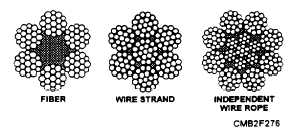SEALE is where larger diameter wires are used on the outside of the strand to resist abrasion and smaller wires inside to provide flexibility.
WARRINGTON is where alternate wires are large and small to combine great flexibility with resistance to abrasion.
FILLER is where very small wires fill in the valleys between the outer and inner rows of wires to provide good abrasion and fatigue resistance.
CORE. - The wire rope core supports the strands laid around it. The three types of wire rope cores are fiber, wire strand, and independent wire rope (fig. 6-35).
A fiber core may be a hard fiber, such as manila hemp, plastic, paper, or sisal. The fiber core offers the advantage of increased flexibility. It also serves as a cushion to reduce the effects of sudden strain and acts as an oil reservoir to lubricate the wire and strands (to reduce friction). Wire rope with a fiber core is used when flexibility of the rope is important.
A wire strand core resists more heat than a fiber core and also adds about 15 percent to the strength of the rope; however, the wire strand core make the wire less flexible than a fiber core.
An independent wire rope core is a separate wire rope over which the main strands of the rope are laid. This core strengthens the rope, provides support against crushing, and supplies maximum resistance to heat.
Grades of Wire Rope
The three primary grades of wire rope are as follows:
Mild plow steel wire rope is tough and pliable. It can stand repeated strain and stress and has a tensile strength (resistance to lengthwise stress) from 200,000 to 220,000 pounds per square inch (psi). These characteristics make it desirable for cable tool drilling and other purposes where abrasion is encountered.

Figure 6-35. - Core construction.
Plow steel wire rope is usually tough and strong. This steel has a tensile strength of 220,000 to 240,000 psi. Plow steel wire rope is suitable for hauling, hoisting, and logging.
Improved plow steel wire rope is one of the best grades of rope available and is the most common rope used in the NCF. This type of rope is stronger, tougher, and more resistant to wear than the others. Each square inch of improved plow steel can stand a strain of 240,000 to 260,000 psi. This makes it especially useful for heavy-duty service, such as on cranes with excavating and weight-handling equipment.
The term lay refers to the direction of the twist of the wires in a strand and to the direction that the strands are laid in the rope. In some instances, both the wires in the strand and the strands in the rope are laid in the same direction; and, in other instances, the wires are laid in one direction and the strands are laid in the opposite direction, depending on the intended use of the rope. Most manufacturers specify the types and lays of wire rope to be used on their piece of equipment. Be sure and consult the operator's manual for proper application.
The five different lays used in wire rope are as follows (fig. 6-36):
RIGHT REGULAR LAY has the wires in the strands laid to the left, while the strands are laid to the right to form the wire rope.
LEFT REGULAR LAY has the wires in the strands laid to the right, while the strands are laid to the left to form the wire rope. In this lay, each step of fabrication is exactly opposite from the right regular lay.
RIGHT LANG LAY has the wires in the strands and the strands in the rope laid to the right.
LEFT LANG LAY has the wire in the strands and the strands in the rope laid to the left.
REVERSE LAY has the wires in one strand laid to the right, the wire in the nearby strand are laid to the left, the wire in the next strand are to the right, and so forth, alternating direction from one strand to the other. Then all strands are laid to the right. 6-22Continue Reading
